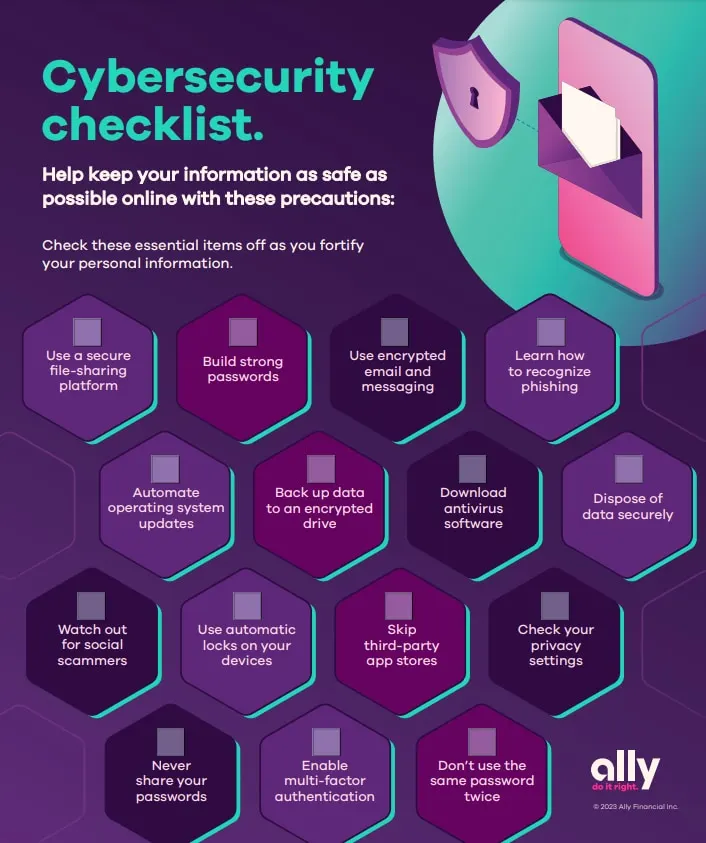What we'll cover
Why cybersecurity is important
A checklist of online safety best practices
Steps you can take to help protect yourself online
Whether you’re paying bills, connecting with friends on social media or keeping up with the news, you probably spend a lot of your time in the digital world. But how much time do you spend on online safety? Start taking stock of your security with these best practices that can help keep you and your information secure.

Automate your operating system updates
If a widespread vulnerability arises, security updates are released quickly to address it. Enabling automatic updates ensures you don’t miss a crucial new safeguard.
Use a secure file-sharing platform
Want to share documents and photos with friends and colleagues? The internet makes file-sharing a snap, but if you don’t want your pics shared beyond your intended audience, it’s important to use a secure platform. A safe service will encrypt data as it’s being transmitted and preserve data integrity.
Build strong passwords
Not all passwords are created equal. Ironclad passwords are original and use a mix of letters, numbers and symbols. Turning a sentence or phrase into a keyword will help you remember passwords. Another simple trick is to double an easy-to-remember password.
Don’t use the same password twice
As tempting as it is, don’t reuse passwords across multiple sites and platforms. If you need help remembering your password, turn a sentence or phrase into a password, and you’re more likely to remember it. Then create password variations based on that password for each platform. You might also consider a password manager, which creates and stores passwords for your various accounts.
Enable MFA when possible
Double down on access control for your online accounts with multi-factor authentication when it’s available. With this protection, you need to use a combination of factors to access your account. You will most commonly enter a knowledge factor, a possession factor or an inherence factor. A knowledge factor requires you to answer a security question or enter a pin, while a possession factor could include a physical item like a badge, token or SIM card. Examples of inherence factors include a fingerprint scan or facial recognition.
Don’t share passwords
Your passwords are only as safe as the people who have access to them, so avoid sharing them with others unless necessary. Others may not take security as seriously as you, so don’t give them the chance to put your information at risk. If you must share a password, prioritize security by transmitting it in an encrypted format (like those shared in the next item below).
Use encrypted email or messaging
Digital communications like email and text messages will always be more secure when encrypted. What does that mean? Encryption is when the information contained within the communication is coded, hidden or distorted to make it tougher for cybercriminals to access. You likely have some kind of encryption through your email and text providers, but it never hurts to check.
If you turn a sentence or phrase into a password, you’re more likely to remember it.
Learn how to recognize phishing
Odds are, you or someone you know has been targeted by phishing (aka cybercriminals pretending to be someone else via email or text). If something seems off or too good to be true, it probably is. Don’t take the bait. Use caution when opening messages or emails from unfamiliar addresses, and don’t click on any suspicious links.
Watch out for social scammers
When savvy hackers use deception to get personal information and use it for fraudulent purposes, it’s known as social engineering. Beware of signs of this strategy when interacting with people you don’t know IRL — like pleas to get your passwords or wire money.
Back up data to an encrypted drive
You already know encryption can protect your emails and messages. It can do the same for your data in the cloud. Encrypting your cloud backup makes your personal info unreadable so it cannot be intercepted.
Download antivirus software
Even if your operating system has built-in antivirus protection, additional software may be beneficial since new threats are constantly emerging. More than 350,000 new pieces of malware and potentially unwanted applications are registered each day, so it’s crucial to stay on top of potential problems.
Dispose of data securely
Just like you cut up an old credit card or shred your bank statements before disposing of them, tossing digital data should also be secure. You might consider using a data destruction or disk wipe service for old computers or hard drives. If you stop using a cloud service, be sure to retrieve all your data and close the account to avoid hackers finding your old information.
Use automatic locks on your devices
You wouldn’t leave your house without locking the front door, use the same amount of caution with your devices. Set up your smartphone or computer to automatically lock after it’s been idle for a minute or more to make sure your devices are not vulnerable. It’s particularly important in case you lose your device or it’s stolen.
Skip third-party app stores
When you download a new game, messaging platform, or any other new app, be sure it’s from a reputable source. Stick to applications from Google Play or the Apple App Store and avoid lesser-known third-party app stores. Beware of apps that pop up and encourage you to download them. They may have dangerous malware.
Check your privacy settings
Whether on social media, online games or any other accounts where you input your personal information, the easiest way to protect it is to avoid giving it away in the first place. Strict privacy settings help you limit what you share with companies. And don’t just set it and forget it. Privacy settings frequently change, so do regular checkups to make sure you’re comfortable.
Check all the cybersecurity boxes
Make your online safety a priority by ensuring you have a comprehensive understanding of all the steps you should take to help protect yourself and your private information on the internet. Use this downloadable checklist to stay on top of your safety best practices in the digital world.
Download our cybersecurity checklist here(PDF 121 KB)



